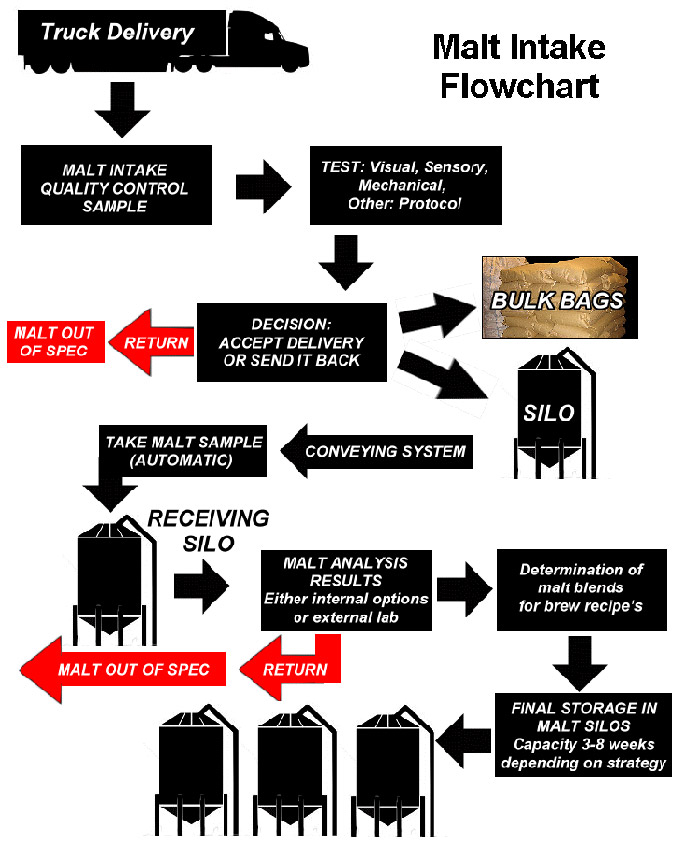Every brewery should have a plan for what they’d like their malt handling flow to look like. There are many aspects to consider and a perfect solution isn’t always easy to come by. Malt handling and all that it entails is often times underestimated and often problems arise due to lack of proper planning and consideration. It is in the best interest of a brewery to find an optimal solution for their malt handling needs.
Here you will find information about:
• Malt supply chain and purchasing of malt
• Malt delivery & receiving.
• Storage of malt at the brewery
• Malt and / or grist transporting.
• Weighing of malt and /or grist.
• Milling (Processing)
• Quality control from receipt of malt through mash
Malt Supply Chain:
Proper inventory control, supply chain management and scheduling ensure that a brewery doesn’t run out of any malt and hence can brew all beers according to schedule. The brewery should also consider economy of scale and inventory and it’s effect on cash flow. Grain cost is volume dependent and order size should be based on projected requirements to maximize savings. Inventory should be kept at levels to ensure malt is fresh.
The critical factors here are how much malt can or should be held in inventory at the brewery, malt producer lead time for delivery, how much storage capacity is available, how many different malt varieties are in use, what varieties are the most sensible ones.
This needs to be handled individually by each brewery depending on the needs.
Malt delivery and receiving:
There are several options of how malt can be delivered, taken into a brewery and stored.
The following diagram shows a suggested malt intake scenario.

Malt can be purchased and stored in:
• Pre milled in bags (~50 lbs – Not recommended)
• Individual sacks (~50lbs)
• Bulk bags (~900 lbs. – ~1600 lbs., ~2700 lbs.) – Bulk bag unloader
• Bulk shipment – (~50,000 lbs) Malt is stored in silos
Malt bags are usually shipped via pallets of 40 bags per pallet (more or less), so having a pallet jack is required but a forklift is more ideal. Pallet racks greatly increase storage capacity but require a forklift. This can be of advantage as far as cost of delivery is concerned since more malt can be purchased at once and shipping cost per pound is more favorable. It is important to rotate stock properly to prevent oxidation or staling.
Malt delivered in bulk bags or super sacks.
This is also a great option to purchase malt since pricing is usually cheaper. Once a bulk bag is put into place, it requires less handling. Typically the brewery would need to install a bulk bag station and it needs to be ensured that malt can be accurately weighed for milling. If a forklift is unavailable then the bulk bag unloader can be outfitted with a hoist and trolley for bag placement. Supersacks are an ideal way to reduce malt costs for mid-sized breweries or ones that can’t install a silo system.
Silo malt
Is typically used for base malts (e.g. 2 row or Pilsener malt) specialty malt can be handled via bulk sacks or via bag malt. Bulk malt in silos is typically the least expensive way to purchase malt. Breweries that start to produce upwards of 2,000 BBL’s annually will start to see a good ROI for a silo system. Startups with an eye on production may want to pre-plan for a silo(s) location for easier implementation in the future. Other advantages of bulk receiving is the minimal effort by cellar workers and reduced risk of injury when compared to bag malt. Delivery via truck is the most common while railroad cars are for very large brewers only.
• A typical truckload of bulk malt is around 15 – 20 tons depending on type of malt. There are multiple options for unloading bulk silo malt. As for the truck delivery and off loading, the most common method is a PD truck that pneumatically blows the malt into the top of the silo. It is advisable to have a brewery team member present during delivery to ensure the truck operator doesn’t push the malt at over 3 p.s.i. It should take 2-3 hours to unload a truck. Higher pressures and faster rates will likely damage malt. It is important that a filter bag be placed on the silo exhaust vent during every fill. Otherwise the dust pollution will be significant and will create an unsightly layer that can also attract insects and rodents
